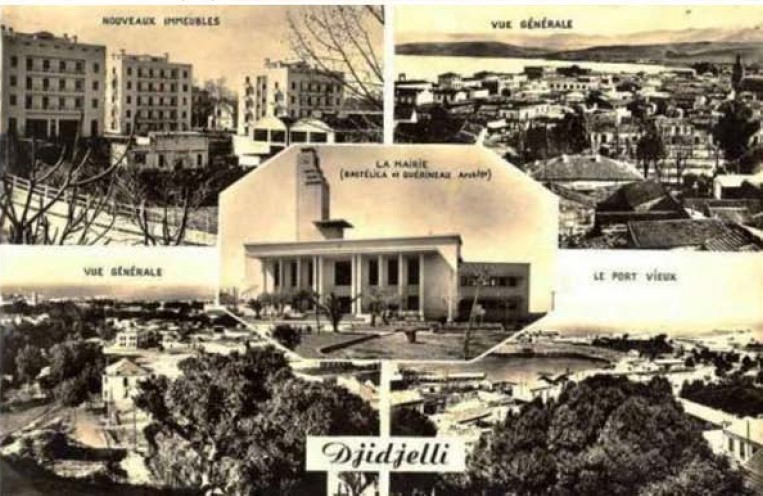Forging the City Image during the French Colonial Period (1883-1962) in the Case of Jijel (Algeria)
DOI:
https://doi.org/10.31522/p.31.1(65).9Keywords:
city image, colonial urbanism, French colonial period (1883-1962), Jijel (Djidjelli), Algeria, urban brandingAbstract
The urban configuration of Algerian cities reflects the influence of French colonization (1883-1962). This is characterized by a collection of contrasts and overlays of different forms of architecture and urbanism. In all urban agglomerations in Algeria, the colonial section remains the most prominent and structured. This legacy of colonial architecture and urban planning has ignited a national debate in political and academic circles regarding its classification as heritage. This current study contributes to the debate by adopting a neutral and scientific approach in order to smooth things out and shed light on the role and creation of urban form and its image, specifically through the example of Jijel. The notion of urban image is explored through colonial architectural achievements, urban planning, and artistic endeavours that were emblematic of the city during the colonial period and continue to be so today. This article showcases various works created during the colonial period in Jijel, those that still convey an identity that defines the city. The concern for this identity is substantiated by a research project that seeks to identify the city's image through significant architectural works across different epochs and determine those that accurately convey the city's identity within the country.
References
Aiche, B. (2006) Le patrimoine architectural des XIX et XXémes siècles en Algérie: Le projet “Euromed Heritage II, patrimoines partagés”. Revue Campus, (3), pp. 29-30.
Ali Khodja, N.; Zeghlache, H.; Benali, F. & Guani, O. (2019) The Use of New Technologies in the Restoration and Conservation of Built Cultural Heritage / the Case of the Statue of Fouara, Setif, Algeria. The International Archives of the Photogrammetry, Remote Sensing and Spatial Information Sciences, 42, pp. 43-46. https://doi.org/10.5194/isprs-archives-XLII-2-W11-43-2019
Attar, A.; Saraoui S. (2022) Evaluation of the Main Properties of the Urban System by the Correlation between the Method of Space Syntax and the Empirical Approach of Kevin Lynch. The Case of Bejaia City in Algeria. Int J Innov Stud Sociol Humanities. 7(6): 141-157. https://doi.org/10.20431/2456-4931.0706014.
Belhadef, M. (2016) “Le Concept ‘Identité’ en rapport avec l’architecture et la ville : de la ville historique à la ville spectacle”, communication lors, dans le procedding de la journée scientifique Organisée par l’EPAU sur le thème “Identité architecturale”, Alger (22. 2.)
Ben Jemia. I. (2014) “L’identité en projets : ville, architecture et patrimoine”, Les Cahiers de la recherche architecturale et urbaine [En ligne], 30/31, mis en ligne le 14 septembre 2017. https://doi.org/10.4000/crau.412
Bennis, S. (2009) Dynamique urbaine et constructions identitaires Cas de la ville de Béni- Mellal (Centre du Maroc), pp. 119-137.
Benzerra, A.; Cherrared, M.; Chocat, B.; Cherqui, F. & Zekiouk, T. (2012) Decision support for sustainable urban drainage system management: A case study of Jijel, Algeria. Journal of environmental management, 101, pp. 46-53. https://doi.org/10.1016/j.jenvman.2012.01.027
Blibli, M.; Bouchair, A. & Hannouf, F. (2015) Apport des technologies numériques à l’étude des fortifications du génie militaire français dans une ville d’Algérie au début de la colonisation: Djidjelli, 1839-1862. Defensive architecture of the Mediterranean: XV to XVIII centuries. Vol. I, pp. 291-298. http://ocs.editorial.upv.es/index.php/FORTMED/FORTMED2015/paper/view/1710
Bouhelouf, Y.; Hadjiedj, A. & Dubois-Maury, J. (2019) Potentialités et projet d’attractivité du territoire de la ville de Jijel (Algérie). Bulletin de l’association de géographes français. Géographies, 96(96-1), pp. 124-145. https://doi.org/10.4000/bagf.4686
Meo, G.D. (2007) Identités et territoires: des rapports accentués en milieu urbain? Métropoles, (1), Ed Varia. https://doi.org/10.4000/metropoles.80
Eshuis, J.; Klijn, E.H. & Braun, E. (2014) Marketing territorial et participation citoyenne: le branding, un moyen de faire face à la dimension émotionnelle de l’élaboration des politiques?. Revue internationale des sciences administratives, 80(1), pp. 153-174. https://doi.org/10.3917/risa.801.0153
Galland, B. (1993) Les identités urbaines. Cultures, sous-cultures et déviance. Convention romande de 3e cycle de sociologie 2e session Bulle, 24-26 novembre 1993.
Ginting, N. & Wahid, J. (2017) Defining distinctiveness aspect of place identity in urban heritage tourism. IPTEK Journal of Proceedings Series, 3(3). http://dx.doi.org/10.12962/j23546026.y2017i3.2435
Hatt, E. (2010) Les enquêtes photographiques auprès des touristes. Un support à l’analyse des représentations microterritoriales des stations balnéaires. Mondes du tourisme, (2), pp. 24-43. https://doi.org/10.4000/tourisme.272
Hillier B. & Hanson, J. (1984) The social logic of space. Cambridge university press. https://doi.org/10.1017/CBO9780511597237
Hillier, B.; Penn, A.; Hanson, J.; Grajewski, T. & Xu, J. (1993) Natural movement: or, configuration and attraction in urban pedestrian movement. Environment and Planning B: planning and design, 20(1), pp. 29-66. https://doi.org/10.1068/b200029
Hillier, B. (1996) Space is the Machine: a configurational theory of architecture. Cambridge University Press.
Kagan, S. (Ed.) (2022) Culture and sustainable development in the city: Urban spaces of possibilities. Taylor & Francis.
Kaufmann, J.C. (2009) “L’identité” Identités. Érès, pp. 55-63.
Labelle, S. (2007) La ville inscrite dans “la société de l’information” : formes d’investissement d’un objet symbolique (Doctoral dissertation, Université Paris IV). Soutenue le 07 décembre 2007. 471 pages. https://shs.hal.science/tel-03611133
Lathuillière, M. (1936) Exposition de la cité moderne d’Alger. In: Architecture d’Aujourd’hui, N°5 mai, pp. 82-86.
Lehmann, S. (2010) The principles of green urbanism: Transforming the city for sustainability. London: Earthscan, pp. 1-15. https://doi.org/10.1080/02673037.2013.878102
Lenzholzer, S.; Klemm, W. & Vasilikou, C. (2018) Qualitative methods to explore thermospatial perception in outdoor urban spaces. Urban Climate, 23, pp. 231-249. https://doi.org/10.1016/j.uclim.2016.10.003
Low, S., Taplin, D., & Scheld, S. (2005). Rethinking urban parks: Public space and cultural diversity. University of Texas Press. https://doi.org/10.7560/706859
Lynch, K. (2020) “The City Image and its Elements”. From: The Image of the City (1960). The City Reader. Routledge, pp. 570-580.
Malaurie, C. (2003) De la carte postale. Les quais de Bordeaux. L’urbain et ses imaginaires. Pessac: MSHA, pp. 67-79. https://doi.org/10.4000/books.msha.9951
Malverti, X. & Picard, A. (1988) Les villes coloniales fondées entre 1830 et 1880 en Algérie (Doctoral dissertation, Ministère de l’équipement, du logement, de l’aménagement du territoire et des transports / Bureau de la recherche architecturale (BRA); Ministère de la recherche et de l’enseignement supérieur; Ecole nationale supérieure d’architecture de Grenoble / Association grenobloise pour la recherche architecturale (AGRA)). hal-01902566.
Marchand, D. (2005) La construction de l’image d’une ville: représentation de la centralité et identité urbaine. In: Robin, M. & Ratiu, E. (eds.), Transitions et rapports à l’espace. París: L’Harmattan, pp. 299-335.
Merzoug, W.; Chergui, S. & Zouaoui, M.C. (2020) The impact of reinforced concrete on the modern-day architectural heritage of Algeria. Journal of Building Engineering, 30, 101210. https://doi.org/10.1016/j.jobe.2020.101210
Mohdeb, R. (1988) L’espace habité et l’habitat dans la ville de Jijel (Algérie). Diss. Aix-Marseille 3.
Mokrane, Y. (2011) Configuration spatiale et utilisation de l’espace dans les campus d’universités, cas du campus Elhadj Lakhdar de Batna. Mémoire présenté en vue de l’obtention Du diplôme de Magister dans l’Option : Architecture dans les milieux arides et semi-arides, Université Mohamed Khider - Biskra.
Mori, K. & Christodoulou, A. (2012) Review of sustainability indices and indicators: Towards a new City Sustainability Index (CSI). Environmental impact assessment review, 32(1), pp. 94-106. https://doi.org/10.1016/j.eiar.2011.06.001
Obad Šćitaroci, M.; Bojanić Obad Šćitaroci, B. & Mrđa, A. (Eds.) (2019) Cultural Urban Heritage: Development, Learning and Landscape Strategies. Springer. https://doi.org/10.1007/978-3-030-10612-6
Önder, D.E. & Gigi, Y. (2010) Reading urban spaces by the space-syntax method: A proposal for the South Haliç Region. Cities, 27(4), pp. 260-271. https://doi.org/10.1016/j.eiar.2011.06.001
Oulebsir, N. (2000) La construction du patrimoine en Algérie de la conquête au centenaire,1830-1930 (Doctoral dissertation, EHESS). https://www.theses.fr/2000EHES0145
Palaiologou, G. & Griffiths, S. (2019) The uses of space syntax historical research for policy development in heritage urbanism. Cultural urban heritage: development, learning and landscape strategies, pp. 19-34. https://doi.org/10.1007/978-3-030-10612-6_2
Phetsuriya, N. & Heath, T. (2021) Defining the distinctiveness of urban heritage identity: Chiang Mai old city, Thailand. Social Sciences, 10(3), p. 101. https://doi.org/10.1007/978-3-030-10612-6_2
Picard, A. (1994) Architecture et urbanisme en Algérie. D’une rive à l’autre (1830-1962). Revue des mondes musulmans et de la Méditerranée, 73(1), pp. 121-136. https://doi.org/10.3406/remmm.1994.1671
Rashid, M. (2019) Space syntax: A networkbased configurational approach to studying urban morphology. The mathematics of urban morphology, pp. 199-251. https://doi.org/10.1007/978-3-030-12381-9_10
Remini, B.; Achour, B. & Albergel, J. (2011) Timimoun’s foggara (Algeria): An heritage in danger. Arabian Journal of Geosciences, 4(3), pp. 495-506. https://doi.org/10.1007/s12517-010-0139-9
Retout, A. (1927) Histoire de Djidjelli. Edition Jules Careonel, Alger.
Roula, F. & Bouchair, A. (2021) Application of the INDI Model of the HQE²R Approach to Assess the Sustainability of a Neighbourhood: Case of Jijel City in Algeria. International Journal of Built Environment and Sustainability, 8(3), pp. 63-75. https://doi.org/10.11113/ijbes.v8.n3.763
Safri, S. (2008) Renouvellement urbain d’un centre ancien en déclin : cas du centre-ville de Jijel. Mémoire de magistère: option ville et projet urbain. Soutenu en février 2008. Université Mentouri Constantine.
Sechi, G. (2018) Le city branding à l’épreuve de l’alternance politique à travers l’exemple stéphanois, Confins [En ligne], 36, mis en ligne le 02 juillet 2018, consulté le 21 août 2022. http://journals.openedition.org/confins/14303; https://doi.org/10.4000/confins.14303.
Spain, D. (2014) “Gender and urban space”. Annual Review of Sociology. 40, pp. 581-598. https://doi.org/10.1146/annurev-soc-071913-043446
Terracciano, A.; Dima, M.; Carulli, M. & Bordegoni, M. (2017, May) Mapping Memory Routes: A multisensory interface for sensorial urbanism and critical heritage studies. In: Proceedings of the 2017 CHI Conference Extended Abstracts on Human Factors in Computing Systems. pp. 353-356. https://doi.org/10.1145/3027063.3052958
Ujang, N. & Zakariya, K. (2015) The notion of place, place meaning and identity in urban regeneration. Procedia-social and behavioral sciences, 170, pp. 709-717. https://doi.org/10.1016/j.sbspro.2015.01.073
Van Nes, A. & Yamu, C. (2017) Space Syntax: A method to measure urban space related to social, economic and cognitive factors. In: The virtual and the real in planning and urban design. Routledge. pp. 136-150. https://doi.org/10.4324/9781315270241
Van Nes, A. & Yamu, C. (2021) Introduction to space syntax in urban studies. Springer Nature, p. 250. https://library.oapen.org/handle/20.500.12657/50404. https://doi.org/10.1146/annurev-soc-071913-043446.
Vincent, J.M. (1992) Le sens des lois. L’année du patrimoine. Numéro un. 1992.

Downloads
Published
How to Cite
Issue
Section
License
Copyright (c) 2023 Rachid Mohdeb, Abdelghani Attar, Selma Saraoui

This work is licensed under a Creative Commons Attribution 4.0 International License.
Copyright (c) 2021 authors and journal.
This work is licensed under a Creative Commons Attribution 4.0 International License.
Authors who publish with this journal agree to the following terms:
In agreeing this form, you certify that:
- You read the ethical codex of the PROSTOR available at journal web.
- You submitted work is your original work, and has not previously been published and does not include any form of plagiarism.
- You own copyright in the submitted work, and are therefore permitted to assign the licence to publish to PROSTOR.
- Your submitted work contains no violation of any existing copyright or other third party right or any material of an obscene, libellous or otherwise unlawful nature.
- You have obtained permission for and acknowledged the source of any illustrations, diagrams or other material included in the work of which you are not the copyright owner.
- You have taken due care to ensure the accuracy of the work, and that, to the best of your knowledge, there are no false statements made within it.
- All co-authors of this submitted work are aware of, and in agreement with, the terms of this licence and that the submitted manuscript has been approved by these authors.






